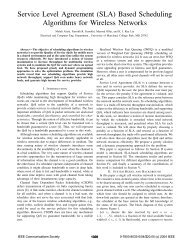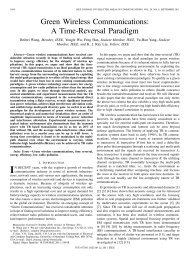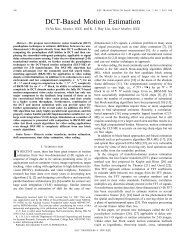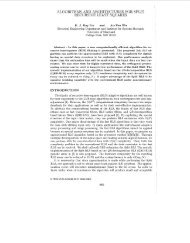A unified square-root-free approach for QRD-based recursive-least ...
A unified square-root-free approach for QRD-based recursive-least ...
A unified square-root-free approach for QRD-based recursive-least ...
Create successful ePaper yourself
Turn your PDF publications into a flip-book with our unique Google optimized e-Paper software.
I<br />
I406 IEEE rRANSACTIONS ON SIGNAL PROCESSING, VOL. 41, NO. 3. MARCH 1993<br />
In VLSI circuit design, sqrt operation is expensive, because it<br />
takes up much area or is slow (due to many iterations). There<strong>for</strong>e,<br />
it is advantageous to avoid or minimize sqrt operations.<br />
By taking out a scaling factor from each row, the two rows under<br />
consideration be<strong>for</strong>e and after the Givens orthogonal trans<strong>for</strong>mations<br />
is denoted by<br />
and<br />
where<br />
,, kh, k6, and kA are the scaling factors resulting in sqrt-<strong>free</strong> - .<br />
operations, and a: and p: are the updated a, and 0, when PI is<br />
zeroed out.<br />
Now, our task is to find the expressions <strong>for</strong>, k:, ki, a;, {(a,’,<br />
b,’), j = 2. . . . , p}, in terms of k,, kh, {(a,, bl),j = 1, . . . ,p},<br />
such that no sqrt operation is actually needed. The sqrt expressions<br />
and 4 in (5) and (6) are used <strong>for</strong> representa-<br />
of a, a, 4.<br />
tional purposes only and are not actually per<strong>for</strong>med.<br />
Replacing a, = &a,, 0, = a b,, ai = &U,’, 6; = &b,’, j<br />
= 1, . . . , p, in (1)-(4) leads to<br />
(6)<br />
s expressions in (18) are not explicitly needed in the computation<br />
of (l3)-(17). The use of the rotation parameter c in (18) (with one<br />
sqrt operation) will be further considered in Section I11 when the<br />
optimum residual e is desired. Furthermore, Section 111 will show<br />
that it is possible to obtain e without any sqrt operation and the<br />
explicit computation of the rotation parameter c can be bypassed.<br />
To avoid repetitive computations and take the advantage of previously<br />
computed results, (14). (16), and (18) use the newly updated<br />
k: of (13). As stated earlier, we are <strong>free</strong> to choose those two parameters<br />
p and U. Different choices of p and U will affect the number<br />
of multiplications and divisions, as well as the numerical stability<br />
and parallelism of these computations.<br />
It can be easily shown that this <strong>unified</strong> view can generate all of<br />
the previously known sqrt-<strong>free</strong> algorithms via a proper choice of p<br />
and U. In fact, there has been more than ten sqrt-<strong>free</strong> algorithms<br />
known so far. Among them are Gentleman [5], Hammarling [9],<br />
Bareiss [I], Kalson and Yao [IO], Ling er al. [Ill, [12], Barlow<br />
and Ispen [2], Chen and Yao 141, Gotze and Schwiegelsohn [8].<br />
For example, if we choose p = 1 and U = 1, it becomes the sqrt<strong>free</strong><br />
algorithm proposed by Gentleman in [5] and can be updated<br />
as follows:<br />
k6 = k,,a: + k,bt (19)<br />
ki, = k,,ki,/kA (20)<br />
a; = 1 (21)<br />
a; = J(k,at + kbbt)/kL<br />
a,’ = (k,a,a, +khb1b,)/kl,<br />
b,’ = -bla, + a,b,.<br />
j = 2, . . . . P<br />
1<br />
a; = [koala, + kbblb,] j = 2, . . . 3 P. To check that these results are correct, we find that<br />
4 Jk,a: + kbb:<br />
To avoid sqrt computation, we need to determine k: and ki such<br />
that ai, a,’, and b,’ will not require sqrt operation. It is clear that if<br />
we choose k,!, and ki as<br />
and<br />
a; = 4 a ; =<br />
-<br />
kuala]<br />
+ khblb,<br />
4<br />
ala, + PIP,<br />
= c,a/ + SIP]<br />
m<br />
(22)<br />
ku kb<br />
k’ - v2(k,a: + kbb:) .IO, - Pia, -<br />
- - -sa, + cp,<br />
(24)<br />
where p and U are parameters that will be determined later to be<br />
any sqrt-<strong>free</strong> function of k,, kb, a,, and b,, then @-(IO) can be<br />
which are consistent with the results in (3) and (4). For the systolic<br />
computed without sqrt operation. We then have the following uparray<br />
implementation described in [13], we choose a, = 1 and dedating<br />
<strong>for</strong>mulas without sqrt operation:<br />
fine the generalized rotational parameters<br />
k: = (koa: + kbb:)/p2 (13)<br />
Then we have<br />
C = k,/k‘:, and S = k,b,/k,!,. (25)<br />
a,’ = Cu, + Sb,<br />
b,’ = b, - bla,.<br />
(27)<br />
(28)<br />
b,’ = u[-b,a, + a,b,] (17)<br />
c = (al/p)a, and s = (b,/p)Jkh/k:,. (18)<br />
Notice that the sqrt operations disappear in our <strong>for</strong>mulas of (13)-<br />
(17), while they are needed in the Givens rotations. Also, the c and<br />
These results are consistent with the works by Gentleman [5] and<br />
McWhirter [ 131. The details of the systolic implementation can be<br />
found in [13].<br />
In Table I, we list various sqrt-<strong>free</strong> algorithms and the corresponding<br />
choices of p and U. Hence, this class of sqrt-<strong>free</strong> algo-






